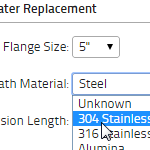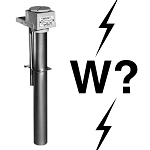866-685-4443 | Get in Touch Online ...
Selecting an Immersion Heater,
from Start to Finish
Our Immersion Heater Tools
Immersion Heater Sheath Selector
Look up the liquid that you'll be heating and get recommendations on sheath materials and power density.

Immersion Heater Configurator
Specify your own built-to-order immersion heater with this tool and get a quote from us in one business day.

Immersion Heater Wattage Calculator
Just enter the details of your process, and this tool calculates the wattage you need.
Choosing an immersion heater, fairly simply, means finding the right answers to a few different questions in order to get the right heater for your job – a heater that won’t burn out or self-destruct, but have a long and uneventful lifetime. This article will highlight what these questions are and how to answer them. Once you know what kind of heater you need, you can either order it online from our extensive standard list of heaters, get a one-day quote with our immersion heater configurator, or get in touch with us by email or phone at (866) 685-4443 to get more information or a quote.
Why am I replacing my immersion heater so often?
We've found that most of the folks we talk to who are replacing immersion heaters on a regular basis have just used stock immersion heaters that are readily available from many general industrial product distributors. Unfortunately, most of those heaters are designed for heating water or oils. Why is that unfortunate? Because many people aren't aware that immersion heaters are specific to the fluid they are intended to heat.
For a long service life from your immersion heater, you’ll need to make sure that both the heater's sheath material and the power density of the elements are appropriate for your application. (If you’re specifying an immersion heater for a new project, these considerations are equally important. It’s not required to learn what happens to poorly specified heaters by seeing it firsthand.) These specifications, of course, are in addition to finding the right wattage, which is the amount of power your heater needs to do its job. To sum up, for the best immersion heater possible, you’ll need to do three things:
- Specify the right sheath material for the fluid being heated,
- Specify the right power density (that is, the watts per square inch or square centimeter), and
- Specify a wattage high enough to heat your fluid to the right temperature.
1. Heater sheath material
How to pick the right sheath
Determining the right heater sheath material for a given liquid isn't difficult, but it does take a little research. Most heater manufacturers publish sheath selection tables. If you've looked at these tables from a few different manufacturers, though, you’ve probably found what appears to be contradictory information. For instance, most everyone agrees that, among the lower cost sheath materials, Incoloy gives the longest service life in potable water applications. But, after that, you'll find some manufacturers who rate copper as a “Best” material while others rate it only as a “Good” material. Who are you going to believe?!
Well, we've gone through all of the selection tables from all of the manufacturers, combined with our own experience, and compiled our own Sheath Material Selector that lists what we feel are “Good,” “Better,” and “Best” sheath materials for applications in specific fluids. You'll also see some explanatory notes in there: for instance, we don't recommend heating flammable liquids directly, and, although most liquids can be heated with PTFE-sheathed heaters, we don't show that in most cases, since it would be overkill and a less expensive alternative will work just fine.
How to pick the wrong sheath
That’s the reliable way to choose a good sheath material. The unreliable way is to just specify a heater sheathed in the same material your tank is made of. It seems reasonable, but applying heat directly to a material acts as a corrosion catalyst. In other words, a 316 stainless steel tank full of 5% nitric acid might last several years before a leak forms, but an immersion heater with a 316 sheath in that same acid concentration might last a few days before it fails.
What happens to a heater with the wrong sheath material? In a nutshell, it fails... sometimes spectacularly. The most common cause of destruction in metal-sheathed immersion heaters is failure due to corrosion. In fact, there are no manufacturers of immersion heaters who will provide a warranty against corrosion – not even us. If the sheath of the heater isn't gobbled up by the chemistry it's heating, over time, even a properly specified immersion heater will develop small pinholes in the sheath.
As long as the heater remains turned on, this might not be a problem. However, when the heater turns off and starts to cool, liquid will seep into the heater element through the pinholes. Then, the next time the heater is turned on, the trapped liquid heats up very quickly – perhaps even vaporizing. Typically, the heated liquid that is trapped in the heater element can't escape quickly enough through the pinholes that let it in, a pressure buildup occurs, and the heater sheath "explodes." Heaters that have died this way look pretty impressive, and it's a good shock to the system when you're around an open tank heated by an immersion heater that’s going through its death throes – not to mention that it creates a safety hazard for anyone in the vicinity.
True story (a cautionary tale)
A few years ago, a customer called us needing to heat a few hundred gallons of 5% nitric acid solution. We got the details on his application, figured out how much power was needed, and told him: "You need a 24-kilowatt PTFE-sheathed heater, and it's going to set you back a little over $3,000."
There was a pause after this number, and then the customer said, "But I've had this 316 stainless tank and it's been working great – quote me a heater with a 316 stainless sheath." We told him that a metal-sheathed heater wouldn’t last – but since two (one for immediate use, one as a spare) of them cost less than a third the price of the PTFE-sheathed heater, he decided to go with metal sheaths.
We set up a pool here in the office, betting how long it would be before we heard from him again. The winner was the guy who bet on five days after delivery. That's right – the 316 stainless steel–sheathed immersion heater lasted exactly five days after it went in the tank. The customer asked us to rush a PTFE-sheathed heater to him, and the next time we heard from him was when he was expanding his operations and needed another heater (PTFE-sheathed, of course) for the new tank.
Why aren’t immersion heaters guaranteed against corrosion?
That's because those of us who provide immersion heaters have no way of knowing what liquid the immersion heater is really going to be used in. For instance, various proprietary solutions – say, for pickling metals – may be mostly composed of a chemical for which we know the appropriate sheath material. But there may be other chemicals present in those solutions that would indicate a different sheath material, and we (or you) have no way of finding out what those other chemicals are.
Another example is when customers tell us they are buying an immersion heater for use in “plain water” – for which we would recommend a regular Incoloy sheath – but tell us later, after the first heater has failed, that their “plain water” is really de-ionized water – for which we recommend the use of passivated Incoloy (Best), passivated Inconel (Better), or passivated 316 stainless steel (Good).
2. Power density (a.k.a. watt density)
There are two main reasons you need to specify the correct power density for your immersion heater:
- To prevent localized overheating or scorching of the liquid being heated, and
- To prevent excess heat buildup in the heater.
What’s interesting is that failure to accomplish #1 usually results in failure to accomplish #2 – or vice versa. Why is that? Well, to get the best life out of any type of heater, it’s important but often overlooked that you need to efficiently remove the heat from the heater. For instance, if you're heating water, the heat needs to be removed from the heater and put into the water – otherwise, it'll have nowhere to go, and the heater will just keep getting hotter.
So, if we build an immersion heater for use in water at the maximum allowable power density (60 W/in²), it will work well in water. But, if you put that heater in oil and turn it on, the heater sheath will rise to an unacceptably high temperature and scorch the oil that’s near to the sheath. That temperature rise happens because oil has a lower thermal conductivity than water, the same way polystyrene has a lower thermal conductivity than steel. If the heater is left on long enough, eventually so much heat will build up that, if the oil doesn't catch fire first, the heater element will melt down.
This is also why running an immersion heater while it's dry is the surest way to cause it to fail: air has a very low thermal conductivity, less than a twentieth of water's.
Choosing the right power density
Some standard chemicals have a widely recommended watt density; these figures are shown in our immersion heater sheath selector tool. Beyond these standard chemicals, it’s up to the manufacturer of the chemical to determine an acceptable power density. If you can’t find the answer online, with the manufacturer, or in your Material Safety Data Sheets, get in touch with us and we’ll figure out a safe power density to work with.
3. Wattage
Once you know the right power density and sheath material, there’s one more thing to do – you have to make sure your heater can actually supply enough heat to bring your liquid to the temperature you need in the time frame required. While finding the watt density and sheath material is as simple as looking them up, calculating your wattage requires gathering a lot of figures and doing some real math.
But no pain is necessary: we’ve created a wattage calculator to automate the whole calculation for you. Just enter in the details of your process – tank volume and size, what liquid you’re using, and so on – and the calculator will show the wattage you need.
Got it! Now what?
With the sheath material, power density, and wattage, plus some idea of the shape of heater you want to put in (over the side, through a flange in the side, etc.), you can find the heater you need in our standard list catalog, or use our configurator to enter your specifications and get a quote in approximately 1 business day.
And of course, if you have any more questions, you can always call us at (866) 685-4443, email us at info@oemheaters.com, or fill out one of our contact forms. We’re here to help you through the whole process.
